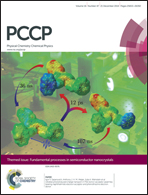The mutual interactions based on amphipathic tetraoxacalix[2]arene[2]triazine: recognition cases of anion and cation investigated by a computational study†
Abstract
The nature of anion⋯π (anion X1–4− = SCN−, PF6−, BF4− and NO3−, respectively) interactions with electron-deficient and cavity self-tunable macrocyclic host tetraoxacalix[2]arene[2]triazine 1 as electron-acceptor (J. Am. Chem. Soc., 2013, 135, 892) have been theoretically investigated with the density functional theory (B3LYP, M06-2X, M06-L, M06, M05-2X, M05, DFT-D3) and the second-order Møller–Plesset perturbation theory (MP2) using a series of basis sets. The binding energies calculated are in good quantitative agreement with the experiments. The LMO-EDA (local molecular orbital energy decomposition analysis) results show that the major contributors of anion⋯π are electrostatic. The alkali metal cations M+ (Na+, K+) and alkaline earth metal cations M2+ (Mg2+, Ca2+) can also interact with 1 and, the cation⋯π binding of M2+⋯1 is stronger than that of M+⋯1, as well as their strength is gradually decreased along with an increase in the radius of M+,2+. The investigation of interplay between the anion⋯π and the cation⋯π shows that the interactions among three-body, X−, 1 and M+ is varied with different phases. The polar solvent can strongly reduce the strength of the interaction, and the more increased the solvent polarity, the more reduced is the binding energy.
![Graphical abstract: The mutual interactions based on amphipathic tetraoxacalix[2]arene[2]triazine: recognition cases of anion and cation investigated by a computational study](/en/Image/Get?imageInfo.ImageType=GA&imageInfo.ImageIdentifier.ManuscriptID=C4CP03551H&imageInfo.ImageIdentifier.Year=2014)

 Please wait while we load your content...
Please wait while we load your content...